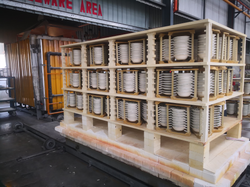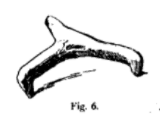
Kiln furniture are devices and implements inside furnaces used during the heating of manufactured individual pieces, such as pottery or other ceramic or metal components. Kiln furniture is made of refractory materials, i.e., materials that withstand high temperatures without deformation. Kiln furniture can account for up to 80% of the mass of a kiln charge.
Materials
Commonly used materials are cordierite (up to 1275 °C), mullite (up to 1750 °C), silicon carbide (up to 1500 °C), alumina (up to 1750 °C), zirconia (up to 1650 °C). The choice depends on cost, weight, and physical properties.
Functions and effects

Functions of kiln furniture include carrying the kiln/furnace load and protecting the load from various kind of damage: open file, smoke, debris, from deforming or sticking the components to each other. In addition to various carriers and plates, capsules with heating material may be used.
Kiln furniture influences the heat distribution in the furnace and the interaction of the load with the atmosphere in the furnace. Since the furniture is being heated along with the load, this increases energy consumption hence the operating costs increase. An additional increase of costs comes from wear of the furniture due to thermomechanical and chemical stresses. To decrease heat capacity porous materials or thinner furniture components may be used. However this calls for a trade-off with load-bearing capacity and stress resistance.
Types of kiln furniture

A saggar (also misspelled as sagger or segger) is a ceramic boxlike container used in the firing of pottery to enclose or protect ware being fired inside a kiln. Saggars have been used to protect, or safeguard, ware from open flame, smoke, gases and kiln debris. Traditionally, saggars were made primarily from fireclay. Modern saggars are made of alumina ceramic, cordierite ceramic, mullite ceramic silicon carbide and in special cases from zirconia.

A pernette or stilt is a prop to support pottery in a kiln so that pottery does not touch each other or kiln's floor. In archaeology, they may be upside-down fired clay tripods, leaving characteristic marks at the bottoms of the pottery/porcelain. They expose the bottom of the fired piece to the full heat.
Other types of furniture and furniture systems include kiln cars, kiln shelves, batts, tiles, and plates; tubes and beams; props and fittings, profile setters, rollers, stools; T-cranks, Y-cranks, pin cranks. The design of kiln furniture system depends on the wares manufactured: structural clay products, dinnerware, tiles, electronics ceramics, sanitaryware, electrical porcelain, etc.
References
- ^ Kiln Furniture, Fraunhofer Institute of Silicate Research
- ^ G. Bickley Remmey, Firing Ceramics, ISBN 9810216793, 1994, Section 4. Kiln Furniture
- 'High Temperature Ceramics for Light-Weight Kiln Furniture' Ceramic Applications 5 (2017) Pg.73
- New Ideas And Proven Solutions For Kiln Furniture Made From Cordierite And Oxide Ceramics. W.Haase & L.Sedda. Ceramic Forum International. Ber.DKG 76, No.7, 1999.
- Saggar Plants In Tableware Production. G. Sper. Interkeram. 41, No.8, 1989.
- A.Dodd & D.Murfin. Dictionary Of Ceramics; 3rd ed. The Institute of Minerals. 1994.
- "Archived copy" (PDF). Archived from the original (PDF) on 2012-03-07. Retrieved 2012-11-26.
{{cite web}}: CS1 maint: archived copy as title (link). - 'A Study of the Properties of Saggar Mixtures. Part XVIII: The Use of Fused Silica as Grog in Saggar Mixes.' White R.P, Rigby G.R. British Ceramic Research Association.RP13. 1948
- 'Kiln Furniture Mixes Containing Highly Refractory Grog'. White R.P, Rigby G.R. British Ceramic Research Association. RP161. 1952
- 'Development Trend Of Dense Alumina Saggar For Electric Materials'. Hayashi K. Ceram. Jap. 38, No.8, 2003. pg.561-563
- 'Silicon Carbide Sagar For Firing Non-oxide Ceramics.' Sakaguchi M., Taskeshita S., Hirota T., Aratani K., Kawakami T. Refractories in the Ceramics Industry. Aachen Proc., 32nd Int.Colloquium on Refractories Aachen, 12–13 October 1989, pg.75-78 Verlag Schmid GmbH
- Sonntag, Kiss; Banhidi, Weber (2009). "New Kiln Furniture Solutions for Technical Ceramics". Ceramic Forum International. 86 (4): 29–34.
- Journal of the American Research Center in Egypt. American Research Center in Egypt. 1965.
- Archæological Researches in Palestine During the Years 1873-1874. Committee of the Palestine exploration fund. 1899.
- Marks and Monograms on Pottery and Porcelain: With Historical Notices of Each Manufactory Preceded by an Introductory Essay on the Vasa Fictilia of England, and Followed by a Copious Index. J. Davy. 1866.
- "PERNETTE English Definition and Meaning | Lexico.com". Lexico Dictionaries | English. Archived from the original on February 21, 2022.
- Kiln furniture, IPS Ceramics